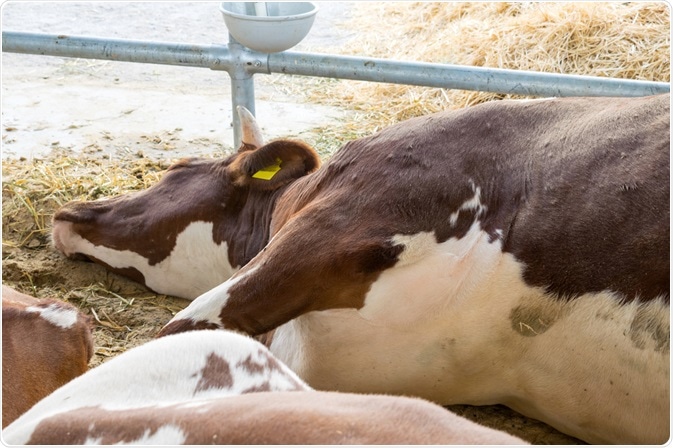Influenza is a respiratory illness that is common to humans and a limited number of animal species – namely domestic and wild birds, pigs, wild aquatic mammals such as seals and whales, minks, and farmed carnivores. Among the three types of influenza viruses, type A virus is the most important as far as cross-species infections are concerned.

Image Credit: Iryna Imago / Shutterstock.com
Although there is a certain degree of host-specificity among influenza viruses, barriers between species are by no means absolute. It is, thus, of utter most importance to understand the zoonotic potential of certain animal influenza viruses, as well as the role of animals in the generation of novel human influenza viruses. Appreciation of the zoonotic nature of influenza viruses and adequate surveillance of animal populations are pivotal steps in tackling future influenza pandemics.
Examples of zoonotic influenza
Influenza viruses were initially isolated from pigs in the United States in the early 1930s. Since then, these viruses have remained one of the most frequently encountered swine respiratory diseases. The isolates were of the H1N1 subtype, and their characterization followed the deadly Spanish flu in 1918. To this day, the question remains open as to whether these viruses first appeared in people and then spread to pigs, or vice versa.
In pigs, influenza most commonly presents in the form of explosive outbreaks of acute respiratory disease characterized by fever, lethargy, nasal and ocular discharge, coughing, dyspnea, and loss of appetite. The disease lasts only for a week, usually with full recovery. Although mortality is low, swine influenza may cause an economic loss due to delayed weight gain.
The nature of influenza virus infections in birds is reliant upon two major factors including the species of the affected bird and the pathogenicity of the virus. The causative viruses are of the H5 and H7 subtypes. The clinical disease develops in chickens and turkeys, while infections in ducks and most other waterfowl are subclinical and therefore do not present with any apparent symptoms.
Lethargy, loss of appetite, weight loss, ruffled feathers, and reductions in egg production are symptoms that follow infection with avian influenza of relatively low pathogenicity, making the diagnosis in the field difficult. On the other hand, highly virulent strains cause fatal systemic disease, which is otherwise known as fowl plague. Fowl plague can be characterized by edema, hemorrhages, and infection of the central nervous system.
Equine influenza is caused by two subtypes of influenza A viruses including H7N7 and H3N8. Clinical signs of these viruses include extreme fever, nasal discharge, and a harsh dry cough. Rarely, pneumonia in young foals and donkeys, as well as encephalitis in horses can develop.
In 2004, cases of an unknown respiratory illness in dogs started to emerge. An investigation showed that the disease was caused by equine influenza A H3N8 virus, which led experts to believe that it “jumped” from horses. Symptoms are also similar to equine influenza, and approximately 80% of infected dogs have a mild form of the disease.
Transmission from animals to people
Wild birds represent the primary natural reservoir for all subtypes of influenza A viruses and are considered as a source of influenza A viruses in all other animals. In addition to swine influenza viruses, pigs can be infected with both human and avian influenza viruses.
Because of such susceptibility to the variety of influenza viruses, pigs are often considered as intermediary hosts or mixing vessels. To this end, pigs can be infected with influenza viruses from different species at the same time, thus creating a milieu for the genes of these viruses to mix and generate a new virus. This event is called reassortment.
Such new virus could adapt to the mammalian host and spread from person to person, but its surface proteins of hemagglutinin and neuraminidase would not be previously seen in influenza viruses that infect humans. This type of abrupt and major change in the influenza A viruses is known as antigenic shift, and it can result in a worldwide influenza pandemic.
How do viruses jump from animals to humans? - Ben Longdon
Highly pathogenic avian influenza A (H5N1) virus, which is often referred to as HPAI H5N1, is a virus that occurs predominantly in birds. H5N1 transmits easily in birds and can be deadly to them, especially to domestic poultry. Even though they are relatively rare, sporadic human infections with this virus have occurred and caused significant morbidity and mortality. Although there is no evidence suggesting efficient human-to-human transmission of HPAI H5N1, researching this virus is one of the top priorities.
Thus far, there is no evidence of canine influenza virus transmission from dogs to people and no reported human infections. As close contact between animals, stress, environmental and meteorological factors have been shown to contribute to influenza virus spread, adequate public health measures and disease awareness remain critical.
References
Further Reading
Last Updated: May 16, 2023